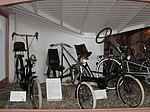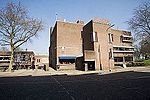Waalbrug
Arch bridgesBridges completed in 1936Bridges in NijmegenBridges over the RhinePedestrian bridges in the Netherlands ... and 2 more
Road bridges in the NetherlandsSteel bridges in the Netherlands

The Waalbrug is an arch bridge over the Waal River in Nijmegen, Gelderland, the Netherlands. The full length of the Waalbrug is 604 metres (1,982 ft), the middle of the arch being about 65 metres (213 ft) high. The arch itself is 244.1 metres (801 ft) long and was the longest arch in Europe at the time of construction. Unlike many other bridges from the same period and with the same construction, like the IJsselbrug near Zwolle, the Graafsebrug and the bridge near Arnhem, the Waalbrug is an arch bridge in the literal sense: all forces truly work on the two pylons.
Excerpt from the Wikipedia article Waalbrug (License: CC BY-SA 3.0, Authors, Images).Waalbrug
Prins Mauritssingel, Nijmegen Nijmegen-Noord
Geographical coordinates (GPS) Address External links Nearby Places Show on map
Geographical coordinates (GPS)
| Latitude | Longitude |
|---|---|
| N 51.851111111111 ° | E 5.8716666666667 ° |
Address
Waalbrug
Prins Mauritssingel
6663 KX Nijmegen, Nijmegen-Noord
Gelderland, Netherlands
Open on Google Maps










